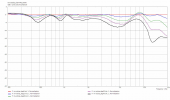Distortion measurements taken outside of an anechoic chamber are irrelevant.
We can only hope that Danny knows better and is deliberately misleading people here.
Measurements in an anechoic chamber are of course optimal, but it is also possible with small quality compromises in a normal environment.
You just have to make sure that the first-order reflections are sufficiently damped. To do this, reduce the measurement distance to the DUT.
This means that you no longer capture all the influences of the baffle and the cabinet and the angle to the drivers becomes steeper (unless you measure each driver individually), but that is the compromise you have to make.
With this you can easily detect possible weak points of the speaker in terms of distortion.
For example, if the mic distance to the baffle is 30cm and the first reflecting surface is at a distance of 150cm (this is usually the floor and ceiling), then the first order reflections will travel a distance of roughly 300cm.
The sound pressure level drop for the first order reflections in the low bass range is thus at least -20dB (as usual the sound pressure decreases by 6dB with doubling the distance). In the worst case of optimal coherent summation or cancellation (reflections arrive delayed, i.e. out of phase), there is a ripple of +-1.5dB for the first two first order reflections of ceiling and floor. If the other reflecting surfaces (such as side walls) are at a greater distance, their contribution is small - more
details how to do the calculation here. In reality, the ripple is likely to be rather less.
In addition, the first-order reflections at 30cm mic distance from the baffle are based on the speaker radiation of about 80° and thus their SPL is reduced even further as soon as the speaker no longer radiates omnidirectional.

Even with small baffles, there is more than -2dB SPL above 200Hz and more than -5dB attenuation of first order reflections above 600Hz.
Which leads to a ripple of less than +-1dB.
Harmonic distortion (HD) is the ratio of the harmonics to that of the fundamental component. This means that small errors due to the ripple caused by the first-order reflections are hardly significant.
With a ripple of +-1.5dB in the fundamental FR, the HD varies between 0.85% and 1.19% around the real value of 1% HD (1% means -40dB attenuation of HD signal).
So even the possible errors due to first order reflections in the low bass range hardly play a role and above 400-600Hz will be insignificant.
So, the real reason for his statement is probably more that his open baffle speakers will perform less well in such measurements and therefore will not be published.







